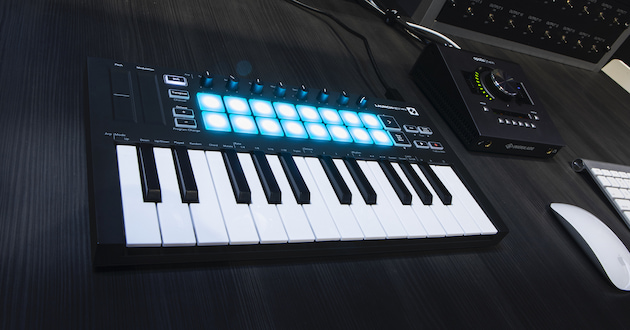Keys to Musical Magic: Unveiling the Diverse World of Piano Keyboards
When it comes to musical instruments, few hold the captivating allure of the piano. With an ocean depth of dynamics and tonal colours, it can express the full spectrum of human emotions, from the gentlest whisper of joy to the most thunderous roar of grief. Originally invented as an answer to the tinny sound of the harpsichord, this instrument has echoed through centuries of musical innovation. From the grandeur of concert halls, where majestic grand pianos take centre stage, to the intimate studios where portable keyboards ignite creativity, the piano’s adaptability knows no limits.

How Many Piano Keyboard Types Are There?
If you’re ready to embark on a musical adventure with your own set of keys, finding the right piano keyboard will undoubtedly enhance your journey. Unlocking the world of music keyboards is like discovering a treasure trove of endless sounds and possibilities. With each type boasting its own distinct features and purposes, delving into this diverse realm is essential for creating the sound you want.
Acoustic Pianos
These are the traditional instruments that create melodious tunes by harnessing the power of vibrating strings. As you press the keys, hammers strike the strings, producing a beautiful, mellow sound. In this category, you’ll find the stunning grand pianos and their compact, elegant cousins the uprights. The former are known for their rich, full-bodied sound, making them a staple in concert halls and formal settings. The latter, on the other hand, offers a more adaptable and space-saving option, perfect for intimate settings and smaller spaces.
Digital Keyboards
Digital keyboards use electronic sensors to produce sound which is often evocative of the feel and tonal richness of acoustic models. Digital piano keyboards come in various sizes, from compact to full size, to suit different needs. These are also available in many configurations, including:
- Stage Pianos: Designed for professional musicians and performers, offering rich, resonant sound, as well as additional features like MIDI compatibility and customisable settings. These key configurations can cover a variety of sounds, making them versatile instruments for different genres.
- Portable Pianos: Typically more compact and lightweight, designed for musicians and students on the go. These units are often used in music education due to their versatility and playability, allowing for easy learning of basic musical concepts.
- Hybrid Pianos: Combining the best of both worlds, these instruments offer an authentic acoustic feel paired with digital conveniences like headphone connectivity and recording capabilities.
Electric Keyboards
Electric or electronic keyboards are feature-rich instruments that often include a wide range of sounds in addition to traditional piano tones. These are often used in bands and live performances across various music genres, including jazz, rock, and pop. One of the most widely known instruments in this category is the synthesizer, which allows musicians to create and manipulate an array of effects and amplification options. Do you know that Slash, the legendary guitarist of Guns N’ Roses, has mentioned using the Yamaha DX7 synthesizer in his creative process? The DX7 has shaped the band’s early sound, particularly on iconic tracks like “Sweet Child of Mine” and “Paradise City”, which demonstrates the multifaceted functionality of the instrument.
MIDI Keyboards
The MIDI keyboard is a piano-style instrument used to control other electronic musical devices like synthesizers and sound modules. Although they don’t produce sound on their own, these keyboards seamlessly integrate with various music production setups, allowing for expressive artistic performance and precise control over virtual instruments.

Other Considerations
Knowing which keyboard type you need is just the beginning, in order to make a wise decision, there are a few additional factors to consider.
Invest in Quality Instruments
First, it’s safe to say that the unwritten rule of “if a deal sounds too good to be true, it probably is” applies to musical instruments as well. Therefore, it’s probably best to stick to reputable brands known for their quality and reliability. Brands like Kawai, Roland, Kurzweil, Yamaha, Arturia and Akai are praised for their high-quality music keyboards that are built to last and offer excellent performance. While it may be tempting to choose a cheaper option from a lesser-known brand, investing in a higher-end keyboard will almost certainly ensure a better overall experience in the long run.
Get Hands-On Experience
Then, the key action is another important aspect that can impact your playing experience. Weighted keys mimic the feel of traditional acoustic instruments, while semi-weighted or synth-action keys offer a lighter touch. Decide which key action suits your playing style best. If you don’t have hands-on experience, consider visiting brick-and-mortar music stores or attending workshops to gain valuable insights and guidance from experts in the field.
Know What You Need
Next, pay attention to connectivity options and additional features. If you’re choosing a digital, electronic, or hybrid instrument, ensure that it has the necessary ports or compatibility with your other devices, whether it’s USB, MIDI, or Bluetooth. As for the additional features like built-in speakers or recording capability, determine whether they are essential for your needs because these can greatly affect the price.

Closing Thoughts
Whether you’re an absolute beginner or a budding artist, choosing the right instrument can undoubtedly enhance your musical journey and bring joy to your playing experience for years to come. And remember, no matter which key configuration you choose, it’s your dedication and passion that will make all the difference at the end of the day. As Johann Sebastian Bach said, “There’s nothing remarkable about it. All one has to do is hit the right keys at the right time and the instrument plays itself.”